The foliar spray segment is projected to grow at the highest CAGR between 2020 and 2025.

The global Crop protection chemicals size is estimated to be valued USD 63.7 billion in 2020 and is projected to reach a value of USD 74.1 billion by 2025, growing at a CAGR of 3.1% during the forecast period, ResearchAndMarkets, said in a release.
The growth of this market is attributed to an increasing need for food security of the growing population.
One of the major challenges faced by the crop protection chemicals market is the development of Genetically Modified (GM) crops, with the evolution of biotechnology and microbiology. New GM seeds can be developed through gene modification to provide them with the natural ability to be pest repellent. This, the development of genetically modified crops in recent years, especially for pest resistance, has been observed to have resulted in a relatively lesser need for traditional crop protection chemicals.
"The market for liquid segment projected to grow at the highest CAGR between 2020 and 2025."
The liquid segment is the most dominant as well as fastest-growing type of mineral in the Crop protection chemicals market.
Liquid pesticides include suspensions (flowable solutions), solutions, emulsifiable concentrates, microencapsulated suspensions, and aerosols. Liquid forms of crop protection chemical products are preferred more by suppliers as well as end-users. Liquid forms offer longer shelf-life with easy handling, transportation, and application.
Also, they are cost-effective, eco-friendly, and sustainable. Companies are investing in the technological development of crop protection chemicals in liquid forms. The liquid forms of crop protection chemicals can either be water-based, oil-based, polymer-based, or their combinations.
"The foliar spray segment is projected to grow at the highest CAGR between 2020 and 2025."
For foliar spray by mode of application in Crop protection chemicals market is the highest contributor in the global market.
The foliar spray mode of application is the most widely used for crop protection chemicals. It can be used for herbicides, insecticides, as well as fungicides. However, it is majorly used for spraying herbicides and insecticides due to labor shortage for removing unwanted weeds manually and also for destroying insect attacks on crops.
"Biopesticide segment is projected to grow at the highest CAGR between 2020 and 2025."
Bioinsecticides are basically biologically originated insecticides. They include various bacteria, viruses, and fungi for insect control. Biopesticides are typically derived from living organisms - of plant or microbial origin. In 1973, the EPA (Environmental Protection Agency) banned the usage of DDT (dichloro diphenyl trichloroethane), which caused crop protection companies to start discovering insecticides that are less toxic. In the 20th century, bioinsecticides were less popular due to less flexibility in terms of money, availability, and application.
However, today, the popularity of biopesticides is increasing rapidly mainly due to their usefulness and efficiency over chemical pesticides. According to FICCI, globally, there are around 175 registered biopesticide active ingredients and 700 products available in the market. The major biopesticides used across the world are bioinsecticides, biofungicides, bioherbicides, bionematicides, and others, which includes sulfur, oil, insect repellent, moth control, and other biochemical.
"The herbicides segment of the Crop protection chemicals is projected to grow at the highest CAGR between 2020 and 2025."
Key companies in the market include DuPont (US), BASF SE (Germany), Dow Chemical Company (US), Bayer CropScience (Germany), Syngenta Ag (Switzerland), Nufarm (Australia), FMC (US), Monsanto (US), ADAMA Agricultural Solutions (Israel), and Sumitomo (Japan).
Subscribe to our newsletter & stay updated.